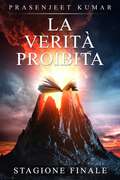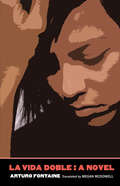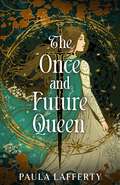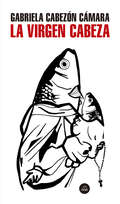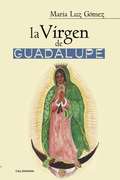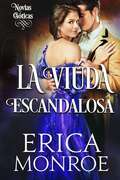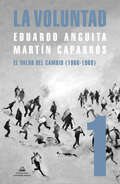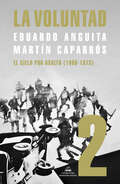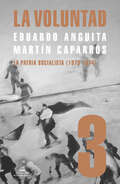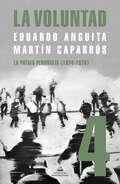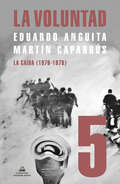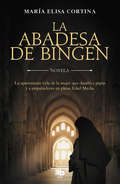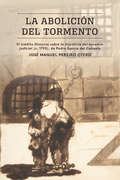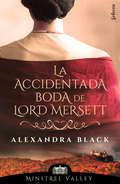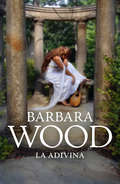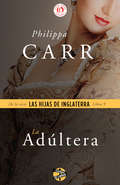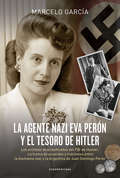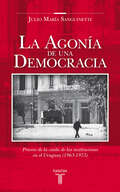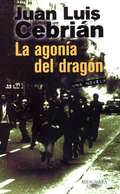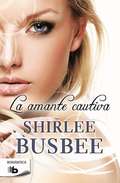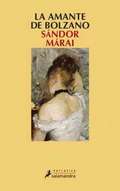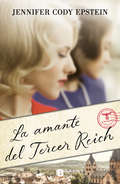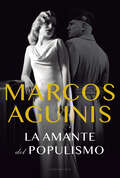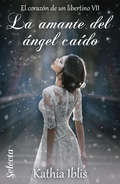- Table View
- List View
La Verità Proibita: Stagione Finale (La Verità Proibita #3)
by Prasenjeet KumarSe desideravi che Harry Potter ricevesse un messaggio, continua a leggere... Dio direbbe: Smettila di andare in questi templi lugubri, oscuri e freddi che hai costruito tu stesso e che dici che sono casa mia. La mia casa è nelle montagne, nei boschi, nei fiumi, nei laghi, nelle spiagge. È lì dove io vivo ed esprimo il mio amore per te. — Baruch Spinoza Il governo corrotto della Sidua ha invocato un incantesimo maligno per controllare le menti dei suoi cittadini, così possono nascondere la loro incompetenza e diventare sempre più ricchi. Cosa può annullare questo incantesimo e fermare il governo della Sidua? L'inafferrabile Libro della Verità. Nel frattempo, Drabu, l'unico e solo profeta del Malsia, sta pianificando una massiccia invasione della Sidua. Chi può sventare Drabu? Ancora una volta, lo stesso segretissimo Libro della Verità. Nella storia che prosegue dai libri La Verità Proibita volume I e volume II, Noora, Ila e Yadu continuano la loro epica ricerca dell'illusorio Libro della Verità. A ogni passo, il loro viaggio diventa sempre più pericoloso, impraticabile e assolutamente frustrante. Riusciranno mai a trovare il favoloso Libro della Verità? O vedranno la loro amata patria ridotta ancora una volta in schiavitù? Preparatevi a cavalcare una storia d'avventura sulle montagne russe, piena di incantesimi, giganti di montagna, maghi e intriganti colpi di scena a ogni passo. Assistete all'epica ed eterna battaglia tra una cultura inclusiva e una esclusiva, tra gli adoratori della natura e il cosiddetto unico e vero Dio, e decidete con chi preferite stare. Se vi sono piaciuti Il Signore degli Anelli e Game of Thrones, vi innamorerete anche de La Verità Proibita e del suo potente messaggio di fondo, eternamente valido.
La Vida Doble
by Arturo Fontaine Megan McdowellSet in the darkest years of the Pinochet dictatorship,La Vida Dobleis the story of Lorena, a leftist militant who arrives at a merciless turning point when every choice she confronts is impossible. Captured by agents of the Chilean repression, withstanding brutal torture to save her comrades, she must now either forsake the allegiances of motherhood or betray the political ideals to which she is deeply committed. Arturo Fontaine’s Lorena is a study in contradictions—mother and combatant, intellectual and lover, idealist and traitor—and he places her within a historical context that confounds her dilemmas. Though she has few viable options, she is no mere victim, and Fontaine disallows any comfortable high moral ground. His novel is among the most subtle explorations of human violence ever written. Ranking with Roberto Bolaño and Mario Vargas Llosa on Latin America’s roster of most accomplished authors, Fontaine is a fearless explorer of the most sordid and controversial aspects of Chile’s history and culture. He addresses a set of moral questions specific to Pinochet’s murderous reign but invites us, four decades later, to consider global conflicts today and question how far we’ve come.
La Vie de Guinevere: Arthurian legend meets time travel in this sweeping romantic fantasy (The Lives of Guinevere)
by Paula LaffertyOutlander-meets-Camelot in La Vie de Guinevere - the first book in a lush, big-hearted, time travel romantasy trilogy
La Virgen Cabeza
by Gabriela Cabezón CámaraLa historia de amor entre Qüity, una cronista de la sección policial de un diario, y Cleopatra, una travesti que ha abandonado la prostitución desde que se le aparece la Virgen. Siguiendo sus consejos, organiza en la villa El Poso, donde viven, una feliz utopía. «Una de las novelas más aptas a esta efervescencia social de la lengua, y también más bellas y agudas.»Silvia Hopenhayn Exuberante y desbocada, barroca y veloz, exquisita y barriobajera es esta novela. "Pura materia enloquecida de azar", como pensaba que era la vida Qüity, la periodista locuaz que termina enamorada de Cleopatra, una travesti carismática entregada al plan salvador que le dicta la Virgen. Del conurbano bonaerense a Miami, esta santísima y plebeya trinidad, sus hijos, amigos y vecinos encarnarán una rebelión popular y sagrada, villera y delirante. Pero ni los milagros, ni la celebración, ni la música que revienta los pasillos de El Poso protegerán a esta utopía fiestera, anticlasista y transgénero. Publicada por primera vez en 2009, La Virgen Cabeza impactó fuerte en el panorama de la literatura nacional. ¿De quién era esa voz personalísima que inscribía su lengua entre la Odisea, la cumbia, el canon argentino y el romancero español? Desmesurada, su autora, Gabriela Cabezón Cámara, obtuvo inmediatamente el elogio unánime de la crítica y el favor de los lectores hacia su proyecto: una revolución en pleno apogeo.
La Virgen de Guadalupe
by María Luz GómezAparecieron las rosas, y en la tilma la imagen de la Virgen. Trata del Imperio azteca; del descubrimiento de América; de la conquista de México por Hernán Cortés; de las apariciones de la Virgen de Guadalupe al indio Juan Diego; del Virreinato; y, tras una época de mayor o menor enemistad, de la paz entre españoles y aztecas. Por último, de la canonización de Juan Diego por el Papa San Juan Pablo II.
La Viuda Escandalosa (Novias Góticas #3)
by Erica MonroeEl escándalo resulta ser mortal en este Romance Gótico de Regencia... Lady Jemma Forster sabe demasiado bien lo crueles que pueden ser las personas chismosas. Sacrificó su propia reputación para restaurar la reputación de su familia. Su matrimonio de conveniencia con un conde acaudalado significó decirle adiós a la pasión, así como a cualquier oportunidad de compartir su amor con el apuesto policía que hacía que su alma ardiera. Ella vive una vida práctica y tranquila como Condesa de Wolverston. Hasta que su marido es asesinado y el único hombre que puede llevar a sus asesinos ante la justicia es su antiguo amor. Gabriel Sinclair, miembro de los Bow Street Runners[1], se ha pasado los últimos tres años intentando olvidar a la inteligente y hermosa Lady Jemma, quien le rompió el corazón cuando se casó con su mejor amigo. La muerte del Conde de Wolverston vuelve a reunir a Gabriel y a Jemma mientras colaboran para encontrar a su asesino. Su investigación les lleva a las zonas más oscuras y peligrosas de Londres, con amenazas que surgen por todas partes. Son los compañeros perfectos para resolver crímenes, pero ¿pueden ser también compañeros en el amor?
La Voluntad 1. El valor del cambio (1966 - 1969)
by Martín Caparrós Eduardo AnguitaEntre la vida y la muerte, un retrato profundo del día a día de los jóvenes revolucionarios de los 70 y un momento excepcional de la historia argentina. «La Voluntad es un intento de reconstrucción histórica de la militancia política en la Argentina en los años sesenta y setenta. Y, también, la tentativa de ofrecer un panorama general de la cultura y la vida en esos años. La Voluntad es la historia de una cantidad de personas, muy distintas entre sí, que decidieron arriesgar todo lo que tenían para construir una sociedad que consideraban más justa. Elegimos las historias que la componen para que ofrecieran un cuadro de las corrientes y los espacios sociales de la época. La elección siempre se puede discutir; por otro lado, no todos los que contactamos quisieron dar su testimonio. Pero creemos que la veintena de relatos que se cruzan en su trama muestran cómo eran la vida cotidiana, los intereses, odios, convicciones, objetivos, miedos y satisfacciones de los que eligieron ese camino.»Los autores Una historia de la militancia revolucionaria en la Argentina 1966-1969 La mañana del 28 de junio de 1966 la radio anuncia el golpe de Estado de Onganía. Casi tres años después estalla el Cordobazo. Entre estos acontecimientos transcurre este primer volumen de La Voluntad, una obra monumental que, en sus cinco tomos, abarca los años cruciales de una generación de militantes revolucionarios. Testigos y protagonistas de una época decisiva del país y el mundo, sus voces -que reflejan el quehacer de organizaciones políticas y clivajes ideológicos diversos- se complementan con una exhaustiva investigación periodística y una minuciosa reconstrucción histórica. A un cuarto de siglo de su publicación, la delicada escritura de la intimidad de esas vidas públicas hace que este proyecto conserve toda su potencia literaria. Y que siga agitando el debate siempre vital al que invitan los proyectos de liberación. La crítica ha dicho... «Es una obra indispensable. Buena parte de la narrativa de ficción sobre los setentas tiene en La Voluntad una cantera muy importante.»Guillermo Saccomanno «Hay que entender el entusiasmo de esos años, leyendo al pie de la letra los testimonios.»Beatriz Sarlo, Punto de Vista «La edición definitiva de La Voluntad, de Eduardo Anguita y Martín Caparrós, pone en perspectiva lo que significó su publicación hace quince años, cuando por primera vez apareció una historia de la militancia revolucionaria en la Argentina sin eufemismos, una apuesta a combatir la desmemoria desde la escritura.»Mora Cordeu, Télam «Más allá del enorme valor que tuvo en su momento, y que por supuesto mantiene, La Voluntad permite comparar el impacto de una misma historia desde dos contextos. Nadie que haya leído este libro en su primera edición y lo relea hoy lo verá con los mismos ojos. Es otro el mirador de la historia.»Revista Ñ «(La Voluntad) tiene el indudable mérito de haber puesto en primer plano el pasado militante de los detenidos/desaparecidos, que hasta el momento se habían visto aprisionados en su papel de "víctimas".»María Virginia Castro
La Voluntad 2. El cielo por asalto (1969 - 1973)
by Martín Caparrós Eduardo AnguitaEntre la vida y la muerte, un retrato profundo del día a día de los jóvenes revolucionarios de los 70 y un momento excepcional de la historia argentina. «La Voluntad es un intento de reconstrucción histórica de la militancia política en la Argentina en los años sesenta y setenta. Y, también, la tentativa de ofrecer un panorama general de la cultura y la vida en esos años. La Voluntad es la historia de una cantidad de personas, muy distintas entre sí, que decidieron arriesgar todo lo que tenían para construir una sociedad que consideraban más justa. Elegimos las historias que la componen para que ofrecieran un cuadro de las corrientes y los espacios sociales de la época. La elección siempre se puede discutir; por otro lado, no todos los que contactamos quisieron dar su testimonio. Pero creemos que la veintena de relatos que se cruzan en su trama muestran cómo eran la vida cotidiana, los intereses, odios, convicciones, objetivos, miedos y satisfacciones de los que eligieron ese camino.»Los autores Una historia de la militancia revolucionaria en la Argentina 1969-1973 Radicales, peronistas, marxistas, comunistas... Los jóvenes militantes que protagonizan esta obra provienen de distintas clases sociales, pero comparten una época absolutamente singular. De la misión espacial que llega a la Luna a la locura desatada por Los Beatles, de la centralidad de la televisión a las expresiones vanguardistas del arte del Instituto Di Tella, del Che Guevara a los curas tercermundistas, el feminismo, el psicoanálisis... De la lucha política a veces sangrienta y casi siempre multitudinaria en calles y plazas al debate ideológico que reconfigura las formas tradicionales de concebir no solo la sociedad, sino también las relaciones de pareja, la sexualidad y la individualidad. Martín Caparrós y Eduardo Anguita consiguen la hazaña de dar cuenta de toda esa riqueza de experiencias históricas a partir de un conjunto de vidas singulares y verterlas al lenguaje de una novela que no se puede dejar de leer. La crítica ha dicho... «Es una obra indispensable. Buena parte de la narrativa de ficción sobre los setentas tiene en La Voluntad una cantera muy importante.»Guillermo Saccomanno «Hay que entender el entusiasmo de esos años, leyendo al pie de la letra los testimonios.»Beatriz Sarlo, Punto de Vista «La edición definitiva de La Voluntad, de Eduardo Anguita y Martín Caparrós, pone en perspectiva lo que significó su publicación hace quince años, cuando por primera vez apareció una historia de la militancia revolucionaria en la Argentina sin eufemismos, una apuesta a combatir la desmemoria desde la escritura.»Mora Cordeu, Télam «Más allá del enorme valor que tuvo en su momento, y que por supuesto mantiene, La Voluntad permite comparar el impacto de una misma historia desde dos contextos. Nadie que haya leído este libro en su primera edición y lo relea hoy lo verá con los mismos ojos. Es otro el mirador de la historia.»Revista Ñ «(La Voluntad) tiene el indudable mérito de haber puesto en primer plano el pasado militante de los detenidos/desaparecidos, que hasta el momento se habían visto aprisionados en su papel de "víctimas".»María Virginia Castro
La Voluntad 3. La patria socialista (1973 - 1974)
by Martín Caparrós Eduardo AnguitaEntre la vida y la muerte, un retrato profundo del día a día de los jóvenes revolucionarios de los 70 y un momento excepcional de la historia argentina. «La Voluntad es un intento de reconstrucción histórica de la militancia política en la Argentina en los años sesenta y setenta. Y, también, la tentativa de ofrecer un panorama general de la cultura y la vida en esos años. La Voluntad es la historia de una cantidad de personas, muy distintas entre sí, que decidieron arriesgar todo lo que tenían para construir una sociedad que consideraban más justa. Elegimos las historias que la componen para que ofrecieran un cuadro de las corrientes y los espacios sociales de la época. La elección siempre se puede discutir; por otro lado, no todos los que contactamos quisieron dar su testimonio. Pero creemos que la veintena de relatos que se cruzan en su trama muestran cómo eran la vida cotidiana, los intereses, odios, convicciones, objetivos, miedos y satisfacciones de los que eligieron ese camino.»Los autores Una historia de la militancia revolucionaria en la Argentina 1973-1974 El breve período que va de la asunción presidencial de Héctor J. Cámpora el 25 de mayo de 1973 a la muerte de Juan Domingo Perón, su mentor y sucesor, el 1° de julio del año siguiente, marcan el apogeo y ocaso de un sueño. La pesadilla ya se había anunciado en Ezeiza, cuando un sector del justicialismo emboscó y tiroteó a la izquierda del movimiento, que también recibía a su líder después del largo exilio. En esos pocos meses, el vértigo de los acontecimientos cambia el signo ideológico de la época y erosiona a la patria socialista. La velocidad de esos días decisivos -acelerados por el triunfo aplastante de la fórmula Perón-Perón en las urnas y el asesinato de Ignacio Rucci por parte de Montoneros poco después- tiene en Martín Caparrós y Eduardo Anguita a sus mejores cronistas. La crítica ha dicho... «Es una obra indispensable. Buena parte de la narrativa de ficción sobre los setentas tiene en La Voluntad una cantera muy importante.»Guillermo Saccomanno «Hay que entender el entusiasmo de esos años, leyendo al pie de la letra los testimonios.»Beatriz Sarlo, Punto de Vista «La edición definitiva de La Voluntad, de Eduardo Anguita y Martín Caparrós, pone en perspectiva lo que significó su publicación hace quince años, cuando por primera vez apareció una historia de la militancia revolucionaria en la Argentina sin eufemismos, una apuesta a combatir la desmemoria desde la escritura.»Mora Cordeu, Télam «Más allá del enorme valor que tuvo en su momento, y que por supuesto mantiene, La Voluntad permite comparar el impacto de una misma historia desde dos contextos. Nadie que haya leído este libro en su primera edición y lo relea hoy lo verá con los mismos ojos. Es otro el mirador de la historia.»Revista Ñ «(La Voluntad) tiene el indudable mérito de haber puesto en primer plano el pasado militante de los detenidos/desaparecidos, que hasta el momento se habían visto aprisionados en su papel de "víctimas".»María Virginia Castro
La Voluntad 4. La patria peronista (1974 - 1976)
by Martín Caparrós Eduardo AnguitaEntre la vida y la muerte, un retrato profundo del día a día de los jóvenes revolucionarios de los 70 y un momento excepcional de la historia argentina. «La Voluntad es un intento de reconstrucción histórica de la militancia política en la Argentina en los años sesenta y setenta. Y, también, la tentativa de ofrecer un panorama general de la cultura y la vida en esos años. La Voluntad es la historia de una cantidad de personas, muy distintas entre sí, que decidieron arriesgar todo lo que tenían para construir una sociedad que consideraban más justa. Elegimos las historias que la componen para que ofrecieran un cuadro de las corrientes y los espacios sociales de la época. La elección siempre se puede discutir; por otro lado, no todos los que contactamos quisieron dar su testimonio. Pero creemos que la veintena de relatos que se cruzan en su trama muestran cómo eran la vida cotidiana, los intereses, odios, convicciones, objetivos, miedos y satisfacciones de los que eligieron ese camino.»Los autores Una historia de la militancia revolucionaria en la Argentina 1974-1976 ¿Cómo se llega al golpe del 24 de marzo de 1976, la herida que marcaría para siempre un antes y un después en la historia del país? Para entenderlo, Martín Caparrós y Eduardo Anguita siguen el día a día de un grupo de militantes populares desde la muerte de Juan Domingo Perón hasta el derrocamiento de su viuda, Isabel Martínez. Entonces, el poder había quedado en manos López Rega, que despliega sus mortíferos escuadrones de la AAA. Las torturas, los secuestros ylos asesinatos provocan el exilio de artistas, intelectuales y militantes, y anuncian la maquinaria de la desaparición del Terrorismo de Estado. La violencia se impone en todos los aspectos de la vida pública y la tragedia va alcanzando, de un modo u otro, a los protagonistas. La crítica ha dicho... «Es una obra indispensable. Buena parte de la narrativa de ficción sobre los setentas tiene en La Voluntad una cantera muy importante.»Guillermo Saccomanno «Hay que entender el entusiasmo de esos años, leyendo al pie de la letra los testimonios.»Beatriz Sarlo, Punto de Vista «La edición definitiva de La Voluntad, de Eduardo Anguita y Martín Caparrós, pone en perspectiva lo que significó su publicación hace quince años, cuando por primera vez apareció una historia de la militancia revolucionaria en la Argentina sin eufemismos, una apuesta a combatir la desmemoria desde la escritura.»Mora Cordeu, Télam «Más allá del enorme valor que tuvo en su momento, y que por supuesto mantiene, La Voluntad permite comparar el impacto de una misma historia desde dos contextos. Nadie que haya leído este libro en su primera edición y lo relea hoy lo verá con los mismos ojos. Es otro el mirador de la historia.»Revista Ñ «(La Voluntad) tiene el indudable mérito de haber puesto en primer plano el pasado militante de los detenidos/desaparecidos, que hasta el momento se habían visto aprisionados en su papel de "víctimas".»María Virginia Castro
La Voluntad. La caída (1976 - 1978)
by Martín Caparrós Eduardo AnguitaEntre la vida y la muerte, un retrato profundo del día a día de los jóvenes revolucionarios de los 70 y un momento excepcional de la historia argentina. «La Voluntad es un intento de reconstrucción histórica de la militancia política en la Argentina en los años sesenta y setenta. Y, también, la tentativa de ofrecer un panorama general de la cultura y la vida en esos años. La Voluntad es la historia de una cantidad de personas, muy distintas entre sí, que decidieron arriesgar todo lo que tenían para construir una sociedad que consideraban más justa. Elegimos las historias que la componen para que ofrecieran un cuadro de las corrientes y los espacios sociales de la época. La elección siempre se puede discutir; por otro lado, no todos los que contactamos quisieron dar su testimonio. Pero creemos que la veintena de relatos que se cruzan en su trama muestran cómo eran la vida cotidiana, los intereses, odios, convicciones, objetivos, miedos y satisfacciones de los que eligieron ese camino.»Los autores Una historia de la militancia revolucionaria en la Argentina 1976-1978 Muy cerca del Estadio Monumental, donde se jugaban los partidos del Mundial 78, funcionaba la ESMA, uno de tantos centros clandestinos de detención y muerte. Allí no solo se torturaba y mataba; también se operaban los vuelos que lanzaban a sus víctimas vivas al Río de la Plata. Para entonces, miles de militantes trataban de subsistir en la clandestinidad; muchos habían sido secuestrados o asesinados. Enfrentadas y diezmadas, las cúpulas revolucionarias toman decisiones impracticables y no consiguen levantar al pueblo contra un gobierno ilegítimo y violento, cuyo plan económico destruye la industria nacional e inicia el ciclo nefasto del endeudamiento externo. Esta saga monumental culmina entre los gritos de júbilo del triunfo mundialista. Para llegar a escuchar los gritos de dolor harían falta años. Y libros fundamentales como este, que recuperaran las historias de los perseguidos. La crítica ha dicho... «Es una obra indispensable. Buena parte de la narrativa de ficción sobre los setentas tiene en La Voluntad una cantera muy importante.»Guillermo Saccomanno «Hay que entender el entusiasmo de esos años, leyendo al pie de la letra los testimonios.»Beatriz Sarlo, Punto de Vista «La edición definitiva de La Voluntad, de Eduardo Anguita y Martín Caparrós, pone en perspectiva lo que significó su publicación hace quince años, cuando por primera vez apareció una historia de la militancia revolucionaria en la Argentina sin eufemismos, una apuesta a combatir la desmemoria desde la escritura.»Mora Cordeu, Télam «Más allá del enorme valor que tuvo en su momento, y que por supuesto mantiene, La Voluntad permite comparar el impacto de una misma historia desde dos contextos. Nadie que haya leído este libro en su primera edición y lo relea hoy lo verá con los mismos ojos. Es otro el mirador de la historia.»Revista Ñ «(La Voluntad) tiene el indudable mérito de haber puesto en primer plano el pasado militante de los detenidos/desaparecidos, que hasta el momento se habían visto aprisionados en su papel de "víctimas".»María Virginia Castro
La abadesa de Bingen
by María Elisa CortinaLa verdadera historia de la mujer que desafió a papas y emperadores en plena Edad Media. Nacida en una familia de fortuna y linaje, a los tres años de edad Hildegarda de Bingen comenzó a tener visiones acompañadas de dolores tan intensos que parecían llevarla a la muerte. A los catorce años fue encerrada, contra su voluntad, en una celda de barro adosada a las paredes de un monasterio de varones. Allí dedicaría su vida solo a la contemplación del Señor. Pero Dios le tenía preparada otra cosa. Sazonada con ingredientes fantásticos y usando como telón de fondo el mundo monástico y el convulsionado siglo XII, esta novela narra la historia de esa joven que desafiando a su mundo fue abadesa, profetisa y médico. Realizó milagros y exorcismo, se vistió con sedas y joyas, escribió de teología y medicina, compuso música, fundó dos monasterios, predicó en público, desafió al mundo masculino y enfrentó a papas y emperadores siendo una de las personalidades más fascinantes del siglo XII alemán. **Novela ganadora del Premio Caligrama 2018, en la categoría Talento.**
La abadesa de Bingen
by María Elisa CortinaLa verdadera historia de la mujer que desafió a papas y emperadores en plena Edad Media. Nacida en una familia de fortuna y linaje, a los tres años de edad Hildegarda de Bingen comenzó a tener visiones acompañadas de dolores tan intensos que parecían llevarla a la muerte. A los catorce años fue encerrada, contra su voluntad, en una celda de barro adosada a las paredes de un monasterio de varones. Allí dedicaría su vida solo a la contemplación del Señor. Pero Dios le tenía preparada otra cosa. Sazonada con ingredientes fantásticos y usando como telón de fondo el mundo monástico y el convulsionado siglo XII, esta novela narra la historia de esa joven que desafiando a su mundo fue abadesa, profetisa y médico. Realizó milagros y exorcismo, se vistió con sedas y joyas, escribió de teología y medicina, compuso música, fundó dos monasterios, predicó en público, desafió al mundo masculino y enfrentó a papas y emperadores siendo una de las personalidades más fascinantes del siglo XII alemán.**Novela ganadora del Premio Caligrama 2018, en la categoría Talento.**
La abolición del tormento: El inédito Discurso sobre la injusticia del apremio judicial (c. 1795), de Pedro García del Cañuelo (North Carolina Studies in the Romance Languages and Literatures #314)
by José Manuel Pereiro OteroJunto a la erradicacion de la esclavitud y de la pena capital, la abolicion del tormento configura durante el siglo XVIII una de las disputas intelectuales mas incisivas de la Europa continental. Una importante e inedita pieza de esta controversia juridica, politica y social en la Espana de la epoca es el Discurso sobre la injusticia del apremio judicial, donde se argumenta a favor de prohibir este y otros metodos legales de coercion fisica y mental. A mediados de la ultima decada del setecientos, su autor, el abogado Pedro Garcia del Canuelo, trata de publicarlo y busca la mediacion de Manuel Godoy. Sin embargo, el futuro Principe de la Paz rechaza proteger el manuscrito y advierte al autor sobre posibles repercusiones si continua examinando dicho asunto. En consecuencia, aunque el titulo ha pasado al registro historico en contadas referencias indirectas, su contenido se creia perdido. La abolicion del tormento no solamente rescata la figura y el trabajo de su autor, sino que analiza, transcribe y reproduce el texto. Ademas, aparte de estudiar las repercusiones de este debate intelectual en ensayos, dramas, textos narrativos y articulos periodisticos, examina los fundamentos filosoficos y legales de la controversia sobre la tortura juridica en Europa y, particularmente, en Espana. La disputa en la que participa el Discurso sobre la injusticia del apremio judicial refleja las tensiones politicas, juridicas y sociales de la epoca, ya que el debate sobre la legitimidad de la tortura implica considerar planteamientos cuya relevancia no se limita al siglo XVIII. Entre ellos se encuentran, por ejemplo, como se puede articular la relacion entre legalidad y justicia, que criterios se usan para definir a un ser humano, que principios establecen el valor intrinseco de la existencia individual, asi como que circunstancias condicionan la igualdad ante la ley, y cuales son los limites del poder legitimo cuando este suspende los derechos naturales, politicos y civiles del ciudadano. Ampliamente documentado, este estudio es de particular interes para quienes reflexionen sobre los cambios en los procesos legales y en las practicas politicas durante la transicion entre el Antiguo Regimen y el liberalismo moderno.
La accidentada boda de lord Mersett (Minstrel Valley #Volumen 8)
by Alexandra BlackContinúa la rompedora serie de «Minstrel Valley», creada por trece autoras de Selecta. Ambientada en la Inglaterra de la Regencia en un pequeño pueblo de Hertfordshire, descubrirás una historia llena de amor, aventuras y pasión. Oriente y occidente unidos en un apasionado romance en los albores del siglo XIX. Derek Lee, conde de Mersett, se enamora de Daphne desde el primer momento en que la ve, a pesar de que ambos son unos niños. Cuando esta se convierte en la protegida de su padre, descubre que nunca habrá otra mujer para él. Sin embargo, tras una serie de sucesos, tres años después de encontrarse con ella la abandona de nuevo para regresar a China y Daphne acaba casándose con otro hombre. Daphne también sabe que no habrá otro hombre en su vida aparte de Derek, pero cuando las circunstancias los separan, decide seguir su camino, porque no puede esperar a que regrese. Cinco años más tarde, el conde regresa y descubre que Daphne ha enviudado, así que decide ayudarla a rehacer su vida. La acompaña a Mnstrel Valley y vive pendiente de sus necesidades. No ha dejado de amarla, pero no quiere arrastrarla a su mundo, así que impone unas normas que los llevan a mantener una relación platónica y clandestina durante cinco años. Pero Daphne no está dispuesta a dejar que se salga con la suya por más tiempo. ¿Será capaz de derribar las barreras que el conde ha levantado entre ellos o su cruzada está abocada al fracaso? Sobre la serie:Minstrel Valley es un proyecto novedoso, rompedor y sorprendente. Trece mujeres que crean una serie de novelas gracias a una minuciosa organización que ha llevado tiempo y esfuerzo, pero que tiene su recompensa materializada en estas catorce novelas que vamos a disfrutar a lo largo esta temporada.Esta labor de comunicación entre ellas, el apoyo mutuo, la coordinación y coherencia no hubiese sido posible sin nuestras queridas autoras, que hacen visible que con cariño, tiempo robado a sus momentos de ocio, de descanso y de familia, confianza, paciencia, esmero y talento, todo sea posible. Desde Selecta os invitamos a adentraros en Minstrel Valley y que disfrutéis, tanto como nosotros, de esta maravillosa serie de regencia. Prólogo de Nieves Hidalgo en Si me lo pide el corazón (Minstrel Valley 1):«Serán novelas divertidas, románticas, dulces, plenas de sentimiento, con personajes que os enamorarán; hasta con leyenda incluida. Historias paridas por la imaginación de unas autoras merecedoras de elogio, no ya solo por su capacidad para ilusionarnos, su disposición a compartir sino, sobre todo, por la manera encomiable de aplicarse al trabajo para ofreceros lo mejor de sí mismas.»
La adivina
by Barbara WoodLa vida de una asombrosa joven con un papel crucial en el Imperio romano. Una gran historia de amor, fe y valor. Roma, 54 d. C. Ulrika, una joven de 19 años, es la hija de una sabia curandera que siempre le ha contado que su padre murió hace años en una batalla. Desde la infancia, Ulrika tiene visiones y un sueño recurrente sobre un lobo que no sabe interpretar. Ante la inquietud de su hija, la curandera decide confesarle la verdad sobre su padre: está vivo y es un gran líder germano llamado Wolf («lobo»). Ahora que Ulrika sabe descifrar el significado del sueño, tiene que encontrar a su padre para avisarle de que un general romano va en su busca con la intención de acabar con él y con todo el pueblo.
La adúltera
by Philippa Carr Estela CantoCasada con un amigo de infancia, Zipporah disfruta de su vida apacible y convencional. Atrás queda el legado de escándalo de su abuela Carlotta. Viaja a Eversleigh, ese sitio cargado de malicia y de peligro, solo para atender la llamada de un anciano moribundo. Pero cuando deja Eversleigh Court, Zipporah ya no será la misma.Incapaz de resistir la sensualidad de un extranjero, Zipporah sucumbe frente a Gérard d'Aubigné y se embarca en una aventura ilícita cuya recompensa es un secreto agobiante. Pronto, el espíritu de Carlotta Eversleigh se enseñorea de su vida, mientras el escándalo, la violencia y el engaño amenazan con destruirla. Nadie saldrá indemne, ni siquiera su hija.
La agente nazi Eva Perón y el tesoro de Hitler: Los archivos desclasificados del FBI de Hoover. La trama de acuerdos y traiciones entre la Alemania nazi y la Argentina de Juan Domingo Perón
by Marcelo Damian GarcíaUn recorrido por las relaciones entre Juan Domingo Perón, Eva Duarte y el nazismo alemán tras la derrota, avalado por las investigaciones que mandó a realizar Hoover al frente del FBI. Con la debacle nazi consumada, el tablero de la política internacional comienza a reacomodarse. Mientras Adolf Hitler, en el exilio, pierde fuerza e influencia, Juan Domingo Perón -alentado por las circunstancias- se propone erigir a la Argentina como una nación rectora de Sudamérica, tomando la posta de la derrotada Alemania e intentando replicar su ímpetu expansionista en la región. ¿Cómo pretende Perón financiar sus planes de dominación? Mediante el expolio de las millonarias fortunas que fueron secuestradas por el nacionalsocialismo alemán y pacientemente trasladadas hasta Buenos Aires. Su mayor obstáculo será nadie menos que su propia esposa, Eva Duarte, quien pondrá en acción sus poderosas conexiones para salvaguardar esos tesoros. La agente nazi Eva Perón y el tesoro de Hitler nace del trabajo de investigación y consulta de cientos de documentos desclasificados -entre ellos, los de las pesquisas que mandó a hacer John Edgar Hoover cuando se encontraba al frente del FBI-, sobre los cuales el historiador Marcelo García construye una irresistible tesis destinada a entrelazar la inesperada y atrapante trama internacional de acuerdos y traiciones entre la Alemania nazi y la Argentina de Perón. El resultado de este enorme trabajo es un libro que revisa uno de los misterios más magnéticos del peronismo desde una perspectiva nueva: la de los conflictos de intereses entre sus dos más grandes figuras.
La agonía de una democracia
by Julio María SanguinettiUna dictadura que no se explica sin la aparición de una guerrillaanterior. En esa diálectica de la fuerza se perderá primero latolerancia y luego la libertad. El 8 de febrero de 1973 irrumpe el Ejército en el escenario políticonacional. Desacata al presidente y emite dos comunicados con suprograma. Pese al apoyo de la Armada comandada por el contralamiranteZorrilla, el presidente Bordaberry capitula en la base de Boiso Lanza.Este proceso de decaimiento institucional culminará en la madrugada del27 de junio del mismo año, cuando el Ejército cierre el Parlamento y loocupe por la fuerza.Se clausura en ese momento una década de enfrentamientos, iniciada en1963, cuando se registró la primera acción de una violencia políticadirigida a sustituir el régimen democrático por un gobierno revolucionario, inspirado en Cuba.
La agonía del dragón
by Juan Luis CebriánLa agonía del dragón recorre las postrimerías del franquismo a través de una generación que posibilitó la llegada de la democracia a España. La primera entrega de una saga que comienza en España en 1968. Abarca cinco años clave en la posterior evolución de la vida política española, lo que podríamos llamar era Carrero, hasta su asesinato en 1973. Tiempos de transformación en una dictadura que parecía eterna. Un drama cuyos personajes -los históricos y los novelescos- tienen encarnadura literaria y representan distintas formas de la pasión y del compromiso. Desde los fascistas a los revolucionarios de extrema izquierda en una amplia gama de posibilistas, acomodaticios, ambiciosos, neuróticos...
La amante cautiva: Campaña San Valentin (Romántica Bolsillo Ser. #Vol. 7)
by Shirlee BusbeeUna novela que lo tiene todo, un argumento que atrapa, una trama bien urdida, unos personajes principales apasionantes y unos secundarios inolvidables. La bellísima y voluntariosa Nicole Ashford aún no conoce lo que es la pasión, pero está destinada para la aventura y el placer más de lo que podría imaginar cualquier mujer de su tiempo. Burlando un despiadado complot contra ella, huye de su aristocrático hogar inglés en un barco corsario con rumbo a los fastuosos refugios de piratas de Nueva Orleans y el exquisito abandono de las recónditas cuevas de las islas Bermudas. Sin embargo, la misma osadía de su fuga la lanza a un peligro aún mayor, como la amante cautiva de un notorio bandido de los mares, el Capitán Sable, cuyos besos, tiernos y apasionados, se apoderan de su alma. ¡Y nada conseguirá apagar las llamas del amor para el cual ambos han nacido!
La amante de Bolzano
by Sándor MáraiDos hombres, una mujer y la huella imborrable del tiempo: La tercera obra de Márai en abordar estos elementos universales. Esta novela escrita en 1940, después de Divorcio en Buda y La herencia de Eszter y antes de la sublime El último encuentro, culmina asimismo con un conmovedor duelo verbal y psicológico, de múltiples connotaciones, que invita a la reflexión. Y aunque en esta ocasión Márai haya escogido un personaje histórico como Giacomo Casanova, el desarrollo de la narración deja bien claro que, más allá de su dimensión real, el famoso gentilhombre veneciano representa el arquetipo del aventurero intrépido, amoral y sin escrúpulos, un símbolo del hombre que, en su afán por encontrar la felicidad, destruye los medios para alcanzarla. Fugitivo de la justicia, Casanova se refugia en Bolzano, ciudad donde reside la única mujer que ha amado en toda su vida. Pese a los años transcurridos desde que perdióa Francesca en un duelo con el conde de Parma, el gran seductor nunca ha podido desprenderse del anhelo de poseer a la otrora bellísima joven. Ahora, el destino pone en sus manos la gran ocasión de saciar su deseo insatisfecho: el conde, viejo, cansado y temeroso de perder a su mujer, que sigue enamorada de Casanova, le ofrece dinero y libertad a cambio de decepcionar a Francesca, para lo cual el cínico y superficial mujeriego deberá, en el transcurso de unas horas, realizar la actuación más difícil de su largo historial donjuanesco. Al caer la noche, mientras Casanova se prepara para acudir al baile de máscaras, Francesca lo sorprende presentándose en su aposento. Antes del alba, con el único instrumento de un discurso sincero y apasionado, la amante ingenua despojará al curtido aventurero de todas sus máscaras, obligándolo a enfrentarse con el terror del vacío, la soledad y el exilio. Reseña:«En La amante de Bolzano, Márai construye un magnífico tratado sobre la pasión absoluta, sobre el deseo y la nostalgia.»La Repubblica «Un diálogo de juego y exhibición dialéctica donde los contrincantes son el amor y la seducción.»El País «La amante de Bolzano es un Sándor Márai genuino, tanto en su concepción trágica de la llama, siempre traicionada, del amor y de la generosidad espiritual, como en la estructuración de un clímax narrativo de tradición escénica.»Quimera «La comprensión del siglo XX quedaría incompleta sin la literatura de Márai.»Letras
La amante del Tercer Reich
by Jennifer Cody EpsteinEl retrato íntimo de una amistad que el nazismo rompió para siempre. Berlín, año 1933. Renate e Ilse se conocen en la escuela y se hacen amigas inseparables, unidas por su pasión por el conocimiento. Pero a medida que el partido nazi gana posiciones en la ciudad, las leyes de Nuremberg pondrán en peligro una amistad que parecía destinada a durar eternamente. Ilse se siente cada vez más atraída por las Juventudes Hitlerianas, mientras que Renate se ve forzada a confrontar un secreto familiar que su familia ha ocultado durante décadas. Una historia de traición y remordimientos que no tendrá su cierre hasta el año 1989, cuando, en Nueva York, Ava Fischer recibe las cenizas de su madre, a la que nunca acabó de conocer bien, junto con un paquete de cartas que no llegaron a enviarse, dirigidas a la mejor amiga de infancia de Ilse, Renate. La crítica ha dicho:«Una absorbente exploración de la amistad, la traición yla posibilidad de cerrar las heridas del pasado.»Booklist
La amante del populismo
by Marcos AguinisUn reportaje histórico a Margherita Sarfatti, amante y biógrafa de Benito Mussolini, que devela detalles inéditos sobre la vida y la trayectoria del dictador y abre la puerta a una lúcida y reflexiva lectura sobre los fascismos y populismos contemporáneos. Margherita Sarfatti (1880-1961), periodista e intelectual italiana hija de una rica familia veneciana de origen judío, fue biógrafa de Benito Mussolini -además de su amante por veinte años- y compartió con él momentos decisivos en la fundación y el crecimiento del movimiento fascista. Marcos Aguinis, tras una extensa y rigurosa investigación, recupera su voz y la despliega en un notable reportaje histórico en el que, a partir de la obra escrita de Margherita, y a través del ensamble de historia, crítica, ensayo y mucho de novela, construye una entrevista singular, en más de un sentido reveladora. La conversación, siempre amable pero nunca complaciente, se desarrolla ágil, aguda, inteligente y desparpajada; en su decurso ningún aspecto de la vida privada y de la acción pública del hombre que impuso a Italia un régimen totalitario y autocrático es dejado de lado, ningún detalle es eludido. Por estas páginas desfilan las primeras armas de Mussolini como periodista, su carrera militar, su ascenso político, su vínculo con Adolf Hitler y su decisiva participación en la Segunda Guerra Mundial, pero también su volcánica intimidad y los aspectos más oscuros de su personalidad. Auténtica obra maestra, La amante del populismo ratifica a Aguinis como uno de los intelectuales más lúcidos de nuestro tiempo.
La amante del ángel caído (El corazón de un libertino #Volumen 7)
by Kathia Iblis¿Aquello que nació bajo la luna llena entre las dunas del desierto del Sahara tendrá una oportunidad? Su Alteza el príncipe Farid Haidar Al-Zaidani ha dejado su vida en Arabia para instalarse en Londres donde está decidido a continuar con su vida. Excepto por un detalle: que no tiene a su lado a la joven de cabellos de bronce que conoció en medio del desierto y le robó algo más que su atención. Evelyn Moore, hija de arqueólogos, finalmente ha regresado a Londres después de haber pasado unos meses en el desierto. Sin embargo, no puede olvidar lo que ocurrió con un misterioso extraño una encantadora noche y que quedó grabado en su alma. ¿Lograrán los dictámenes sociales y enemigos inesperados separarlos?
